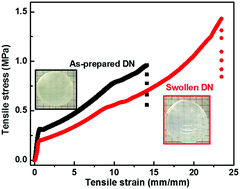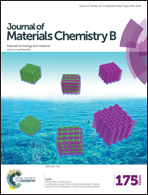A comparative study of the mechanical properties of hybrid double-network hydrogels in swollen and as-prepared states
Abstract
Significant efforts have been made to develop highly tough hydrogels towards many scientific and industrial applications. However, most of the as-prepared tough hydrogels lose their mechanical strength and toughness when they swell in aqueous solution. Current knowledge about the swelling-induced mechanical property changes mainly stems from single-network (SN) hydrogels and chemically linked double-network (DN) hydrogels, but little is known about the swelling mechanical properties of hybrid physically–chemically linked DN gels. Here, we synthesized hybrid agar/PAM DN hydrogels combining a physically cross-linked first network of agar and a covalently cross-linked second network of polyacrylamide (PAM), with particular attention paid to the relationship between the swelling and mechanical properties of the hydrogels. The optimal agar/PAM DN gels achieved a tensile stress of ∼1.0 MPa and a toughness of ∼3988 J m−2 in the as-prepared state and a tensile stress of 1.4 MPa and a toughness of ∼3960 J m−2 in the swollen state. The agar/PAM DN gels can readily achieve swelling ratios in the range of ∼1.3–3.6 by adjusting the concentrations of the first network, the second network, and the crosslinker. The swelling capacity of the agar/PAM DN gels was balanced by the competition between the “non-swellable” agar network and the “highly swellable” PAM network, indicating that the first and second networks play different roles in the swelling-induced mechanical properties of the agar/PAM gels. Based on a comparison of the tearing and tensile behaviors of the hybrid DN gels between both as-prepared and swollen gels, we proposed a swelling-induced fracture mechanism that is different from those of SN and chemically-linked DN hydrogels. This work not only demonstrates a very tough swollen DN gel with a hybrid network, but also provides a better understanding of the swelling characteristics of hybrid DN gels, which hopefully helps to offer some valuable insights into the development of next-generation tough hydrogel materials in both as-prepared and swollen states.

- This article is part of the themed collection: 2016 Journal of Materials Chemistry B Hot Papers

 Please wait while we load your content...
Please wait while we load your content...